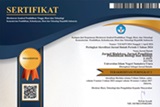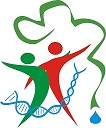Designing a SETS-based biology teaching module: Efforts to enhance students’ critical thinking and problem-solving skills
Abstract
Based on the problem analysis, 10th-grade students at SMAN 1 Talawi show low critical thinking and problem-solving skills. This research aims to determine the level of validity, practicality, and effectiveness of developing biology teaching modules based on the SETS model to enhance students' critical thinking and problem-solving abilities. The type of research used is research and development with the Plomp model. The research data were analyzed using a Likert scale and t-test. The research results show that the biology teaching module based on the Science, Environment, Technology, and Society (SETS) model has a validity score of 87.91%, with very valid criteria. The practicality assessment shows a score of 84.52% with a very practical criterion. The average score for the critical thinking ability test is 83.85, and the average score for the problem-solving ability test is 83.00. These scores indicate that the effectiveness assessment falls into the high criterion with a very effective interpretation. The results of the t-test show that the P-value < α, so the alternative hypothesis (H1) is accepted. So, it can be concluded that the biology teaching module based on the SETS model that has been developed falls into the category of very valid, very practical, and very effective for enhancing the critical thinking and problem-solving abilities of tenth-grade students. The use of technology in this module is one of the novel aspects, where students are involved in exploring and analyzing issues about ecosystems and environmental changes through technology.
Keywords
Full Text:
PDFReferences
Agus, M. A., Khaeruddin, & Ristiana, E. (2022). Pengaruh Pembelajaran IPA Berbasis SETS (Science, Environment, Technology and Society). Journal of Education, Language Teaching, and Science, 4(2), 317–328.
Aliyah, S., & Widiyatmoko, R. (2022). Entrepreneurship-Based Biotechnology E-Module Development to Improve Critical and Creative Thinking Skills. Biosantifika, 4(3), 454–462.
Amanda, S., Muharrami, L. K., & Ahied, M. (2018). Peningkatan Kemampuan Berpikir Kritis Siswa pada Pembelajaran IPA Menggunakan Model Pembelajaran Berbasis Masalah yang Berbasis SETS. Journal of Natural Science Education Reseach, 1(1), 57–64.
Anggraena, Y., Ginanto, D., Felicia, N., Andiarti, A., Herutami, I., Alhapip, L., Iswaya, S., Hartini, Y., & Listyo, R. (2022). Panduan Pembelajaran dan Asesmen. Badan Standart, Kurikulum, dan Asesmen Pendidikan Kementrian Pendidikan, Kebudayaan, Riset, dan Teknologi Republik Indonesia.
Arif, D. S. F., Zaenuri, & Cahyono, A. N. (2020). Analisis Kemampuan Berpikir Kritis Matematika pada Model PBL Berbantu Media Pembelajaran Interaktif dan Google Classroom. Seminar Nasional Pascarjana, 323–328.
Astuti, N. H., Rusilowati, A., & Subali, B. (2021). STEM- Based Learning Analysis to Improve Students’ Problem Solving Abilities in Science Subject: a Literature Review. Journal of Innovative Science Education, 10(19), 79–86.
Azizah, N., & Alberida, H. (2021). Seperti Apa Permasalahan Pembelajaran Biologi pada Siswa SMA? Journal for Lesson and Learning Studies, 4(3), 388–395.
Bradley, S., & Price, N. (2016). Critical Thinking: Proven Strategies To Improve Decision Making Skills, Increase Intuition And Think Smarter. CreateSpace Independent Publishing Platform.
Bunt, B., & Gouws, G. (2020). Using an artificial life simulation to enhance reflective critical thinking among student teacher. Smart Learning Environments, 7(12), 1–19.
Facione, P. A., & Gittens. (2013). Critical Thinking: What it is Why It Counts (pp. 1–13). California Academic Press.
Fairley, N., Fernandez, V., Richard Plouet, M., Guillot Deudon, C., Walton, J., Smith, E., Flahaut, D., Greiner, M., Biesinger, M., Tougaard, S., Morgan, D., & Baltrusaitis, J. (2021). Systematic and Collaborative Approach to Problem Solving Using X-ray Photoelectron Spectroscopy. Applied Surface Science Advances, 5(3), 100–112.
Fauziah, F. M. (2022). Systematic Literature Review : Bagaimanakah Pembelajaran IPA Berbasis Keterampilan Proses Sains yang Efektif Meningkatkan Keterampilan Berfikir Kritis? Jurnal Pendidikan MIPA, 12(3), 455–463.
Fitriani, A., Zubaidah, S., Susilo, H., & Al-Muhdhar, M. H. I. (2020). The Effects of Integrated Problem-Based Learning, Predict, Observe, Explain on Problem-Solving Skills and Self Efficacy. Eurasian Journal of Educational Research, 85, 45–64.
Hidayat, R., Siregar, E. Y., & Elindra, R. (2022). Analisis Faktor-Faktor Rendahnya Kemampuan Pemecahan Masalah Matematis Siswa di SMK Swasta Teruna Padangsidimpuan. Mathematic Education Journal, 5(3), 114–120.
Judijanto, L., Muhammadiah, M., Utami, R. N., Suhirman, L., Laurensius, Boari, Y., Lembang, S. T., Wattimena, F. Y., Astriawati, N., & Laksono, R. D. (2024). Metodologi Research and Development (Teori dan Penerapan Metodologi RnD). Sonpedia Publishing Indonesia.
Kanphukiew, S., & Nuangchalern, P. (2024). Enhanching Scientific Problem Solving and Learning Achievement of Lower Secondary Students Through Active LearningJurnal Pendidikan IPA Indonesia. Jurnal Pendidikan IPA Indonesia, 13(1), 172–181.
Khasanah, N. (2015). SETS (Science, Environmental, Technology and Society ) sebagai Pendekatan Pembelajaran IPA Modern pada Kurikulum 2013. Seminar Nasional Konservasi Dan Pemanfaatan Sumber Daya Alam, 270–277.
Kosasih. (2021). Pengembangan Bahan Ajar. PT Bumi Aksara.
Kumar, T., Mohammad, S., Hashemifardnia, A., & Mombeini, R. (2023). Self vs. peer assessment activities in EFL-speaking classes: impacts on students’ self-regulated learning, critical thinking, and problem-solving skills. Languege Testing in Asia, 13(36), 1–22.
Laia, H. T., & Harefa, D. (2021). Hubungan Kemampuan Pemecahan Masalah Matematis dengan Kemampuan Komunikasi Matematik Siswa. AKSARA: Jurnal Ilmu Pendidikan Nonformal, 07(02), 463–474.
Lubis, J. A., Saputra, R., Tuah, S., Adrian, M., & Padhilah, S. (2023). Canva-assisted biotechnology module based on Marsialap Art’s local wisdom: The endeavor to Improve students’ creativity skills. Jurnal Biolokus, 6(2), 168–177.
Maulyda, M. A., Hidayati, V. R., Rosyidah, A. N. K., & Nurmawanti, I. (2019). Problem Solving Ability of Primary School Teacher Based on Polya’s Method in Mataram City. Jurnal Pendidikan Matematika, 14(2), 139–149.
Mayasari, A., Asrizal, & Usmeldi. (2023). Effect Size Pengaruh Pembelajaran Berbasis SETS terhadap Kemampuan Berpikir Kritis dan Hasil Belajar Siswa. Jurnal Pendidikan IPA, 13(1), 67–76.
Nurhasanah, D. S., & Luritawaty, I. P. (2021). Model Pembelajaran REACT terhadap Kemampuan Pemecahan Masalah Matematis. Plusminus: Jurnal Pendidikan Matematika, 1(1), 71–82.
Nurwahidah. (2023). Upaya Meningkatkan Aktivitas Belajar, Keterampilan Berpikir Kritis, dan Pemahaman Konsep Biologi Siswa Melalui Penerapan Model Pembelajaran Berbasis Masalah. Jurnal Penelitian Dan Pengabdian Kepada Masyarakat Bidang Ilmu Pendidikan, 4(1), 11–21.
Palennari, M., Lasmi, & Rachmawati. (2021). Keterampilan Pemecahan Masalah Peserta Didik : Studi Kasus di SMA Negeri 1 Wonomulyo. Jurnal Pendidikan Dan Pembelajaran Biologi, 5(2), 208–216.
Perdana, P. A., & Rosana, D. (2023). Pengembangan Eksperimen Virtual Model SETS Berbasis Augmented Reality Materi Ekosistem untuk Meningkatkan Keterampilan Pemecahan Masalah dan Sikap Peduli Lingkungan. Indonesian Journal of Science Education, 11(1), 152–164.
Plomp, T., & Nieveen, N. (2013). Educational Design Research: An Introduction. International Slo Publication.
Prasetyo, T., & Zulela. (2021). Proses Pembelajaran Daring Guru Menggunakan Aplikasi Whatsapp Selama Pandemik Covid-19. Jurnal Elementaria Edukasia, 4(1), 138–150.
Puspita, L., & Putri, R. A. (2020). Analisis Keterampilan Berpikir Kritis: Pengaruh Model Pembelajaran SiMaYang Berbantuan Concept Map pada Materi Struktur dan Fungsi Jaringan. Bioeduscience, 4(1), 82–89.
Putra, D. T., Candra, O., Dewi, C., Hastuti, & Zaswita, H. (2022). Electric Drive Training Kit Sebagai Produk Inovasi Media Pembelajaran Praktikum Mahasiswa Pendidikan Vokasi: Analisis Uji Praktikalitas. Jurnal Inovasi Pembelajaran, 8(1), 106–120.
Rahman, M. M. (2019). 21 st Century Skill “Problem Solving”: Defining the Concept. Asian Journal of Interdisciplinary Research, 2(1), 64–74.
Riduwan, & Sunarto. (2012). Pengantar Statistika. Alfabeta.
Rohmatun, H., & Rasyid, A. (2022). Model Pembelajaran SETS (Science, Environment, Technology, Society Berbantuan Media Video terhadap Pemahaman Konsep Siswa. Seminar Nasional Pendidikan, FKIP UNMA, 118–125.
Santiani, Ngabekti, S., Sudarmin, & Rusilowati, A. (2023). Development and Validation Model of Peatland Conservation through Interdisciplinary Science Learning. Biosantifika, 15(1), 134–142.
Satria, R., Adiprima, P., Wulan, K. S., & Harjatanaya, T. Y. (2022a). Dimensi, Elemensi, dan Subelemen Profil Pelajar Pancasila pada Kurikulum Merdeka. Badan Standart, Kurikulum, dan Asesmen Pendidikan Kementrian Pendidikan, Kebudayaan, Riset, dan Teknologi Republik Indonesia.
Satria, R., Adiprima, P., Wulan, K. S., & Harjatanaya, T. Y. (2022b). Panduan Pengembangan projek Penguatan Profil Pelajar Pancasila. Badan Standart, Kurikulum, dan Asesmen Pendidikan Kementrian Pendidikan, Kebudayaan, Riset, dan Teknologi Republik Indonesia.
Simanjuntak, M. F., & Sudibjo, N. (2019). Improving Students’ Critical Thinking Skills and Problem Solving Abilities Through Problem-Based Learning. Journal of Holistic Mathematics Education, 2(2), 108–118.
Suci, N. K. A. A., Pudjawan, K., & Parmiti, D. P. (2020). Pengaruh Model Pembelajaran CORE Berbasis SETS terhadap Hasil Belajar IPA Siswa Kelas V SD. Mimbar Pendidikan Indonesia (MPI), 1(3), 301.
Sumiantari, N. L. E. (2019). Pengaruh Model Problem Based Learning terhadap Kemampuan Pemecahan Masalah IPA Siswa Kelas VIII SMP. Jurnal Pendidikan Dan Pembelajaran Sains Indonesia, 2 (1), 12–22.
Suriati, A., Sundaygara, C., & Kurniawati, M. (2021). Analisis Kemampuan Berpikir Kritis pada Siswa Kelas X SMA Islam Kepanjen. Jurnal Terapan Sains Dan Teknologi, 3(3), 176–185.
Trilling, B., & Fadel, C. (2020). 21st Century Skills: Keterampilan Abad 21: Pembelajaran untuk Hidup di Zaman Sekarang (Juhrodin, U. Penerj). Yayasan Yapata Al-Jawarni.
Utari, T., Lubis, K., & Rahmah, S. (2023). Developing a biotechnology practicum guidebook for producing nata de coco to increase students’ learning outcomes. Jurnal Biolokus, 6(2), 156–167.
Utomo, A. P. (2020). The Effectiveness of STEAM-Based Biotechnology Module Equipped with Flash Animation for Biology Learning in High School. International Journal of Instruction, 13(2), 463–476.
Walsh, M. E., Witherspoon, E. B., Schunn, C. D., & Matsumura, L. C. (2023). Mental Simulations to facilitate teacher learning of ambitious mathematics instruction in coaching interactions. International Journal of STEM Education, 10(9), 1–23.
Yuliani, W., & Banjarnahor, N. (2021). Metode Penelitian Pengembangan R&D dalam Bimbingan dan Konseling. QUANTA, 5(3), 111–118.
DOI: http://dx.doi.org/10.30821/biolokus.v7i1.3942
Refbacks
- There are currently no refbacks.
Copyright (c) 2024 Jurnal Biolokus: Jurnal Penelitian Pendidikan Biologi dan Biologi
indexed by :












